York is England's finest example of a medieval town, so well preserved that it has become one of the world's most interesting historic cities, with a rich mix of activities for the visitor. York is a walker's paradise with endless fascinating sights packed into a small area of one square mile. This fortified town is dramatically surrounded by a high stone wall that protected it from attackers in the past and then shielded it from modernization in that sheltered area enclosed by the wall.
We present a walking tour here covering the main streets in the historic center and a stroll along the fortified wall around the town. But York has so many wonderful attractions that we have four pages covering various other aspects of this amazing city.
Be sure to also look at our other York pages:
The town center is one of the few major cities in Europe completely free of automobiles, dedicated entirely to the pedestrian, filled with beautifully preserved buildings. This is not just a couple of streets without traffic, but an entire zone with a dozen small lanes that you can easily navigate on your own without fear of getting lost.

This is England's largest pedestrian zone, filled with places to eat, shop, and walk around. Even more unusual are the many little alleys that run between the buildings, connecting streets at mid-block, creating a crooked maze that is fun to explore.
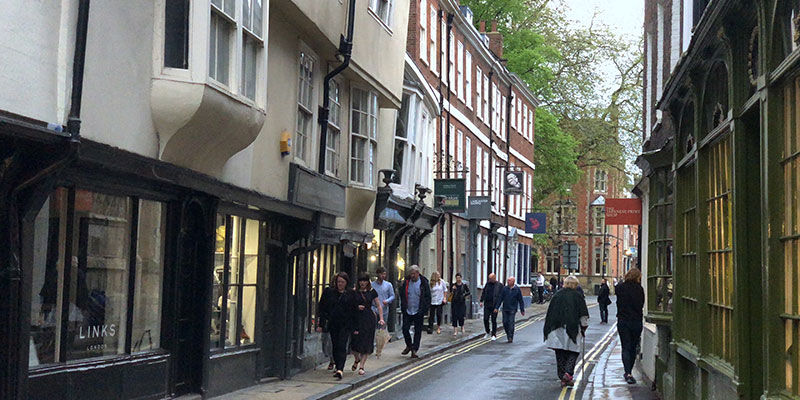
The surrounding wall dating to the Middle Ages is 95 percent intact and nearly three miles long, making it the nation's longest continuous stretch of medieval fortifications. A hundred other towns in Great Britain had fortified walls, but only York has such a grand state of preservation. Moreover, it is the only place where the walls were constructed on top of an earthen mound, making them that much more imposing.
A logical place to begin our walk is at the train station, assuming you have arrived by rail, which is a convenient way to get here. Upon exiting the station you immediately notice the signature attraction of town, the massive wall that we shall walk on later.

The map shows the walking route, and various little detours into side lanes will be suggested. For greater details refer to the Google Map later in the story.
Turning left on Station Road, cross the bridge over the River Ouse and have a glance at the Museum Gardens, explored later.
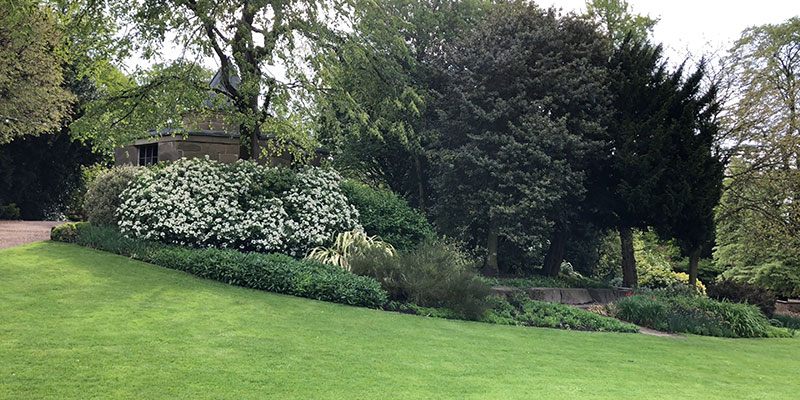
Continue straight on to the Minster, the immense gothic cathedral that is so magnificent we devote an entire page to it. Built 800 years ago and still the tallest building in town, it is the number-one attraction of York, but rather than visiting inside it now let’s get started on our walking tour through these picturesque little lanes.

The streets are narrow and wind in all directions with many old timber and plaster dwellings featuring overhanging stories, and high-peaked red tile gables. You'll be walking right through history, passing some 300-year-old buildings.
We'll take a circular, back and forth route around the pedestrian center showing you the various main lanes, starting in front of the Minster on Petergate, one of the best shopping streets.
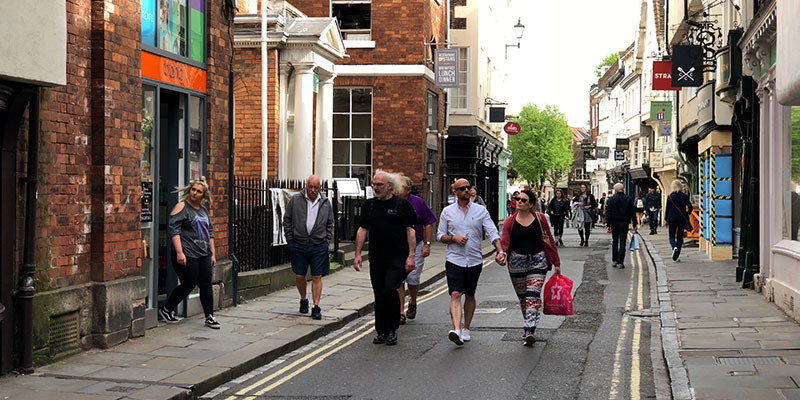
Cars are not allowed in the area we are now entering, called Within the Walls. There will be some delivery vehicles in the morning, perhaps, and working vehicles with permits, but generally pedestrians are free to just stroll down the middle of the roads here, making it a perfect place to meander. It seems every few steps, you'll pass another place to eat — perhaps a nice French restaurant, or a snack shop, or maybe a pub.

It is a miracle that these old buildings are preserved so well, and thanks to modern urban planning and the thriving tourism economy, the businesses are all thriving. Of course York is one of the most popular visitor destinations in the country, so tourists do bring a lot of money which helps all the merchants. As you'll notice walking around, there are a lot of places to do some spending.
At the end of Petergate we arrive at King's Square, a relatively large plaza that's a lively gathering place.
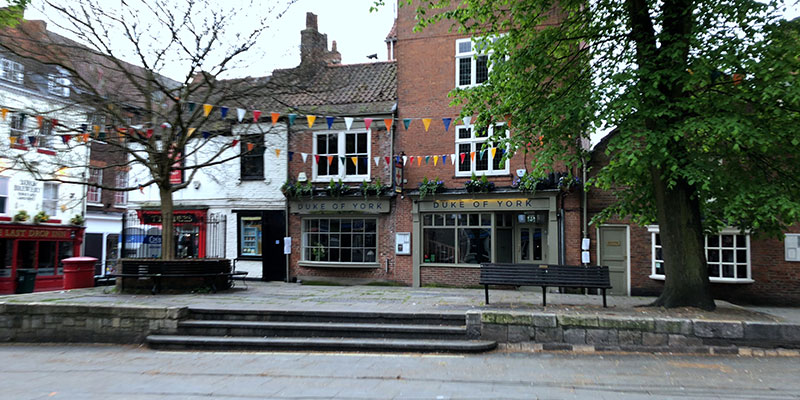
As the name might imply, King's Square is central in old York, with six streets emanating from it and old buildings all around. It's a tree-shaded plaza, with benches to sit and some pubs to enjoy, and it will lead us right into the most famous little street in town.
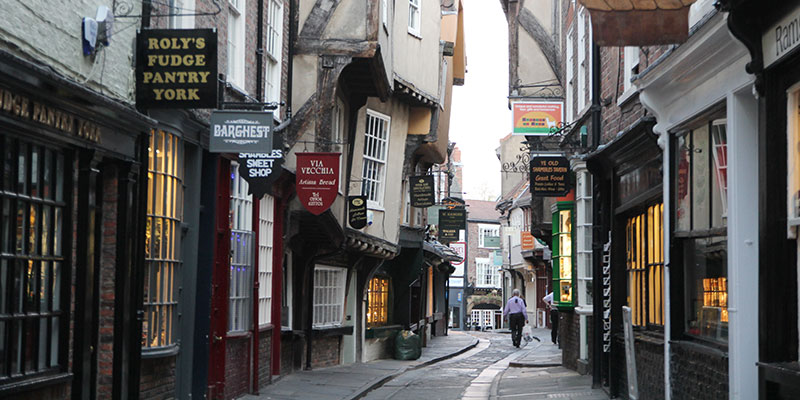
This lane is so narrow and lined with such picturesque old buildings that it probably ranks as the most famous and popuilar site in the city. The buildings are so close together, they say it was possible for neighbors to reach out across the street from their second-story homes and shake hands.
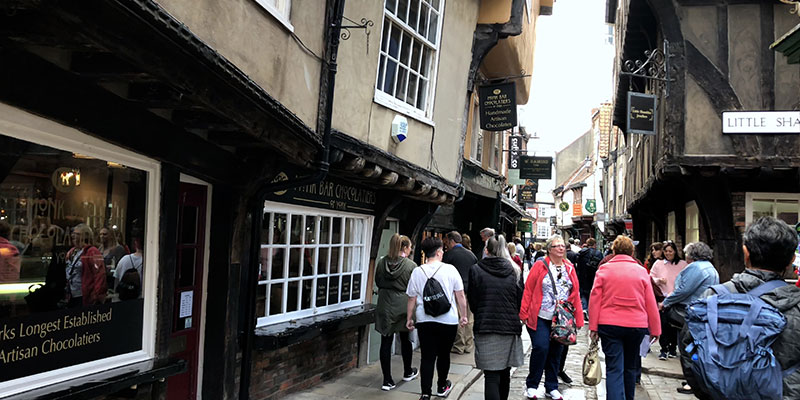
You'll probably return here as you wander through the town, but you'll find the best time to enjoy the Shambles and get an uncluttered photo and experience is early morning or evening when the shops are closed, and the crowd is absent. Be sure to have a look at the Shambles in those peaceful times, for this narrow quaint shopping lane fills up with people during the day, something like bumper cars at rush-hour.
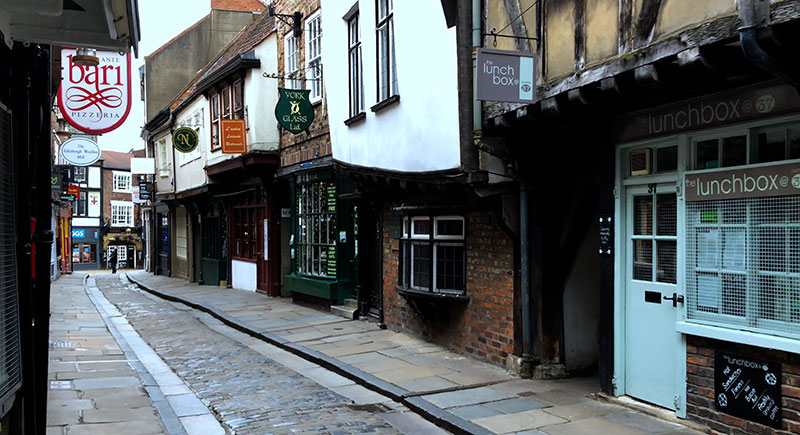
Many of the buildings on this historic lane date back to the 14th and 15th centuries, when it was used as a row for butchers. Even a hundred years ago there were 30 butcher shops, but none remain now. Mostly it's a mix of restaurants and retail, and there's a bookshop and a bakery, or drop in for a cup of tea.
The lane is not just for tourists. You'll see locals out with their kids and walking their dogs, maybe showing them off for passersby, and the locals like to do some people watching too.

I did not spot any loose cats walking around, but there are plenty of dogs here, almost always on their leash. A shop sign advertising sandwiches says "Yorky,” which is what you can call somebody who lives in York, they are Yorkies, and yes, the Yorkshire Terrier originated in the same area.
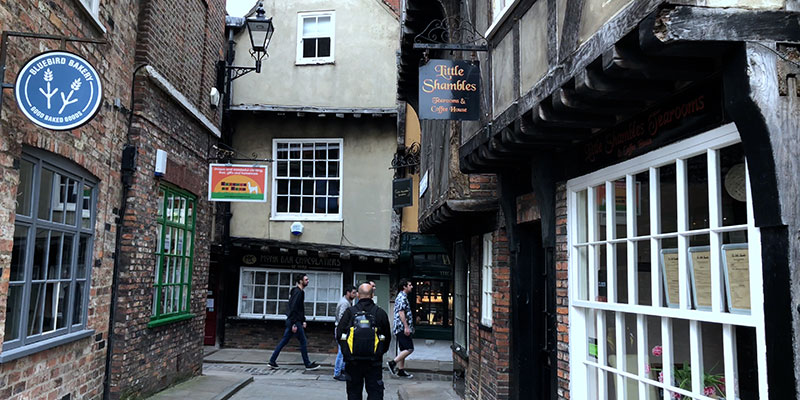
There are five little alleys leading off from the Shambles that you might enjoy exploring, called Snickelways. They are kept quite clean and have some shops and homes sprinkled along them, with much interesting old architecture to admire. If this appeals, you can come back later to explore these little alleys, even in mid-day, for most visitors overlook these hidden gems. They are best explored with help from a local tour guide. One little lane from Shambles leads to Whip-Ma-Whop-Ma-Gate, the longest name for the shortest street in town. It's this half-block – nothing special but the name.
Watch the video about the Snickelways of York.

Little Shambles is the widest lane that branches out and this is a quite interesting one because it leads over to the open-air Shambles Market, open just about every day with dozens of stalls.
They have got all kinds of things for sale here from food to T-shirts, jewelry, old junk, hardware, pots and pans, electronic goods, hats and just great stuff everywhere. Wander around, take some pictures, chat with the local merchants and just have a great time here at the market.

It's a rare example of authentic merchandise not imported from any other country, but right here in England. And you can have a snack or lunch at the outdoor café.
Back over to Shambles to complete our walk, and at the end we come across the street called Pavement, which soon becomes a street called High Ousegate, yet another route just for pedestrians.
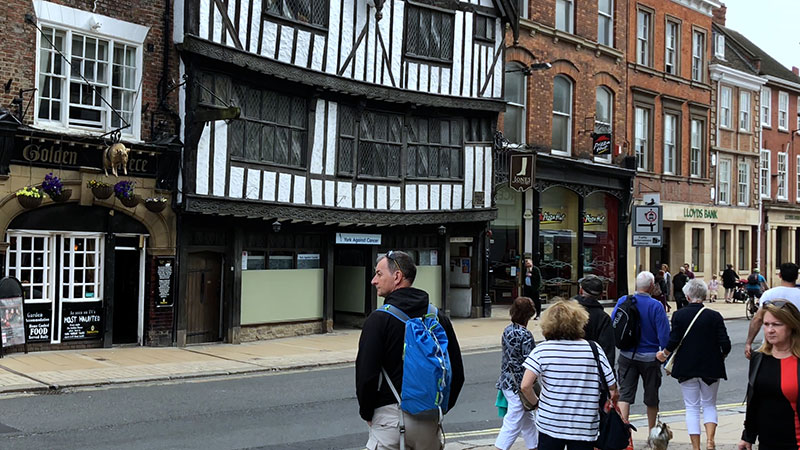
This connects up with the widest of all the pedestrian lanes in York center, called Parliament. It's more of a plaza or a park rather than a street, with lots of stores along and benches, specifically designed in the mid-19th century as a market street. It continued as the city's primary market until the 1950s, and in 1990, it was pedestrianized.

Once in a while they have a special street market, much bigger than the one that we just saw by the Shambles. The kiosks and vendors are organized by a group called Marketplace Europe, which stages 70 major market events every year across the United Kingdom. It features food and merchandise from all over the world.

York also has one of the UK's top-10 Christmas markets. It runs from the middle of November right up through Christmas Eve, which would also be a very nice time to be here. Wintertime in York is much less crowded with tourists, and not bitter cold, and all of the shops, hotels, and restaurants are open.
Early in its history York had been a major commercial center. Starting from the year 1212 when King John granted the city's first charter that confirmed trading rights for commerce in England and Europe.

And then during the later Middle Ages, the York merchants imported wine from France, cloth, wax, canvas and oats from the Low Countries, timber and furs from the Baltic, and they exported grain to Gascony, and wool to the Low Countries. York then became a major cloth manufacturing and trading center.
The economy got a major boost when the railroad arrived in York in 1839 and established York as a major rail center by the late 19th century. Of course, tourism is now a major component of the economy, but this is very much a city for the local residents as well.
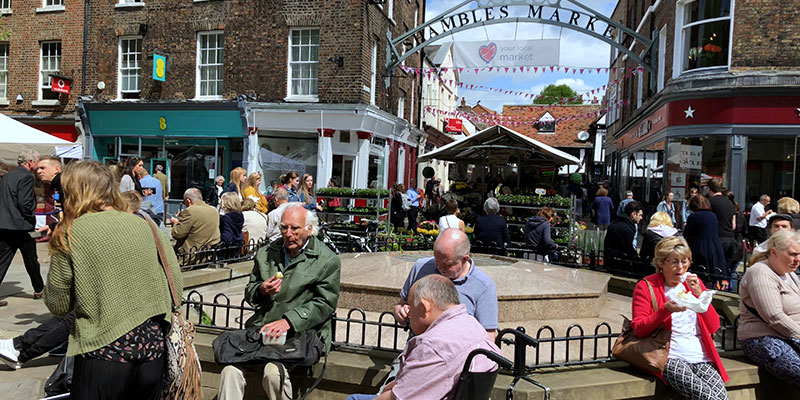
In 2018 York was was described as the Best Place to Live in Britain by the Sunday Times newspaper, and that same year, there was a national survey done of opinions of how people like their cities, and York came out on top with 92 percent of its residents saying they like it here. This is a very livable place, whether you are a resident or just visiting for a day or two.
Parliament connects back into Shambles Market.
The extension of Parliament, called Davygate, connects in with St. Helen's Square, another major focal point of the city, with St. Helen's Church at one end, and the Mansion House at the other, the official residence of the Lord Mayor of York.
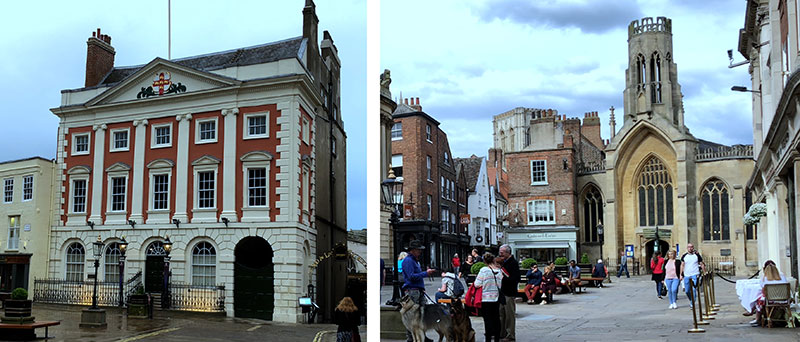
Open to the public as a small museum, it was first occupied in 1732 by the Lord Mayor, and that's a tradition that continues to this day. Built in the early Georgian style, it's the oldest purpose-built house for a Lord Mayor in the country.
There is a famous restaurant on St. Helen's Square where you can have a fabulous meal. It's called the IVY. For many years there was only one IVY restaurant and that was a very exclusive place in London.
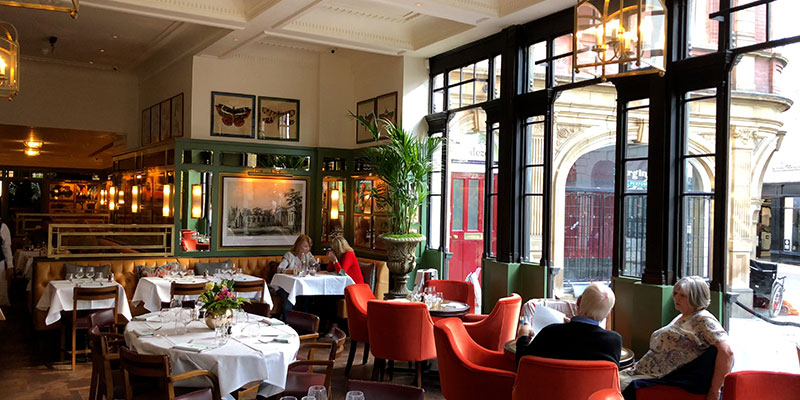
But now, IVY has expanded and is found in dozens of locations throughout the British Isles. So while in York, you have a chance to enjoy some superb food here, open from 9 AM until 10 PM, with a casual atmosphere, and several dining rooms for breakfast, lunch, afternoon tea, dinner or just some drinks.
Even if you're not looking for something to eat, it's a real pleasure just to hang out here at St. Helen's Square, a lively place with four streets leading into it. Coney Street is one of those lanes extending out from St. Helen's Square. It's quite a wide pedestrian street - one of the major arteries of town.
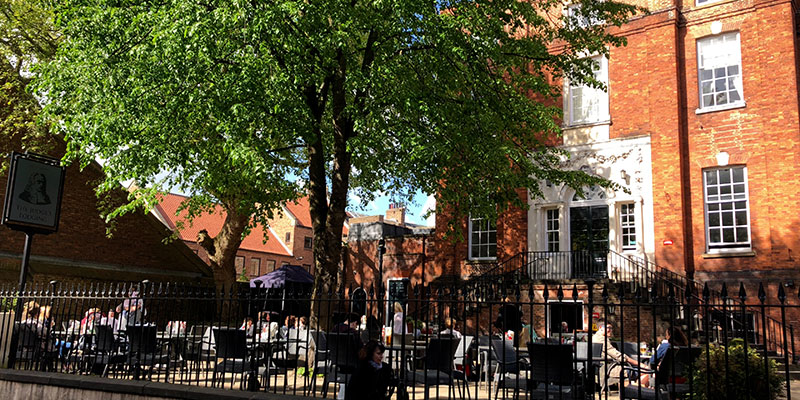
With the large number of excellent restaurants to pick from, you might need a whole week, such as the Judge's Lodging, near St. Helen's Square, on Lindal. It's part of a five-star boutique hotel that's located in a Georgian townhouse that was built in the early 1700s.
Another nice restaurant a block away on Blake Street, right next to the tourist information office, is Ask Italian. It's located in the Grand Assembly Rooms, which were built 300 years ago in the Palladian style of architecture. Tall Corinthian columns'll surround you in this elegant setting that was originally used for high-class social gatherings.
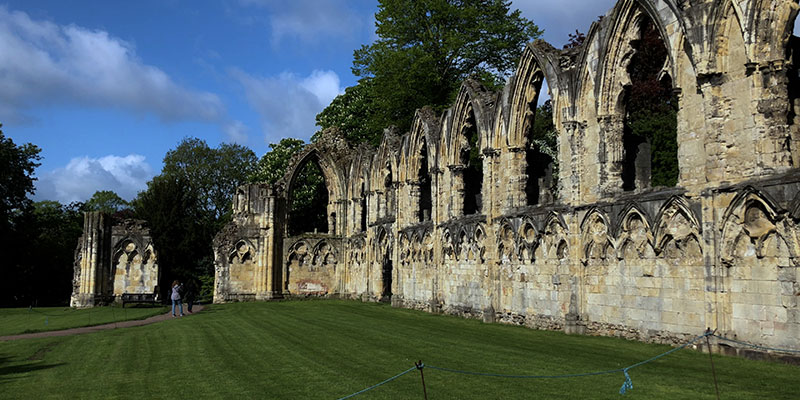
We are one block away from the Museum Gardens that we passed by earlier, so let's pop in and have a look. Get away from the city streets and step into a natural setting, with several spectacular historic ruins.
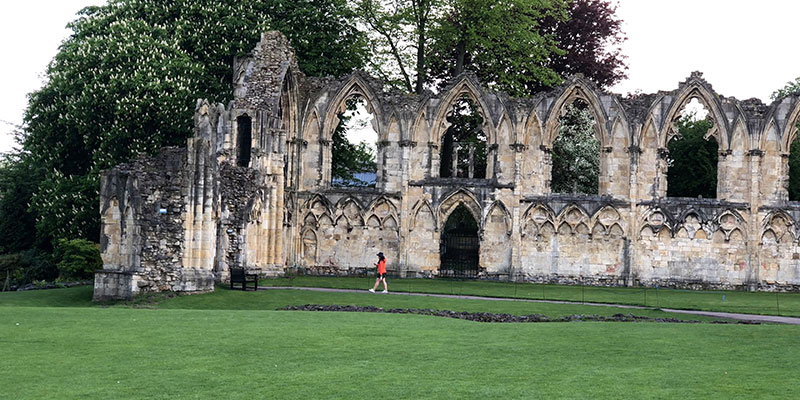
The old wall and row of pointed arches are the remains of St. Mary's Abbey, which was first built by William the Conqueror in 1088. It became one of the wealthiest and most powerful Benedictine monasteries in England. However, this ended in the 1530s with King Henry VIII, who banned all monasteries. The monks were pensioned off, and the Abbey buildings were converted into a palace for the king when he visited York. They fell apart and became these picturesque ruins.

A much older historic site in the park is a wall and tower, the only significant remains of the ancient Romans. The Romans occupied York until the beginning of the fifth century, and during that time it was one of their most important cities in England and was a base for the armies that kept the defenses at Hadrian's Wall, the northern boundary of the Roman Empire. The Romans founded York in 71 BC, and some of their artifacts are on display in the Yorkshire Museum, which we describe in our page on museums.

Aside from all the history, the gardens are just a lovely place to relax. And it turns out to be a nature preserve for a bunch of squirrels, typical of English parks, and they are well taken care of. A group of good Samaritans come over to the park nearly every day to feed the squirrels and play with their little furry friends, who all seem to know each other and get along quite well.
"And then I'm going to go to the next area and feed there. Breakfast. So we leave them in the shells, and they have to break the shells open, so it's good for their teeth."
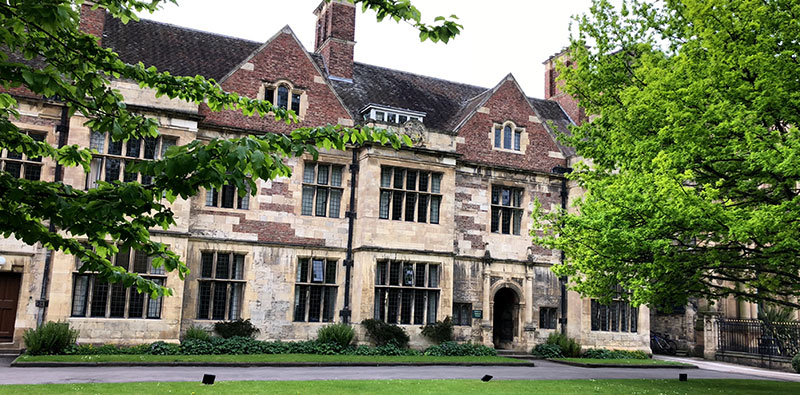
Then we continue walking from the Museum Garden one more block around the corner to the King’s Manor, which began life as the residence of the Abbott who looked after that Abbey in the gardens. When Henry VIII visited, it was converted into a royal palace. And several future kings also stayed here in their travels, including Charles I, who came here several times. That's his coat of arms on top of the door. The buildings are now part of the University of York.

Just next door is the Theater Royal which has been putting on live performances since 1744. The building has been drastically altered over the years, most recently in the early 1990s when a thorough overhaul renewed the facilities with new seats, lighting, ventilation and other major improvements.
In the 1960s a dramatic addition was made to the building when a very modern glass-walled cafe and shop were attached to the outside in a prize-winning design that transformed the rustic, stone exterior wall into a stunning interior surface for the restaurant. There are sculpted stone heads on the facade representing characters from Shakespeare. The theater is on St. Leonard's Crescent, a graceful curved stretch of road built in the Regency style.
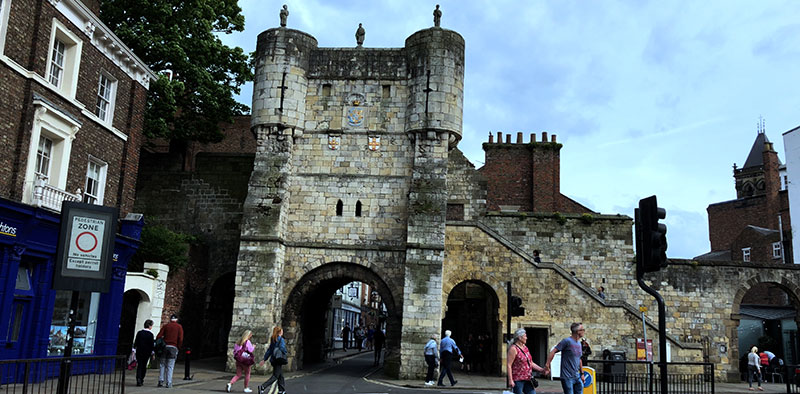
Across the street is one of the main gates into the old city, called Bootham Bar, which provides one of the best access points for a walk along the medieval walls of York.
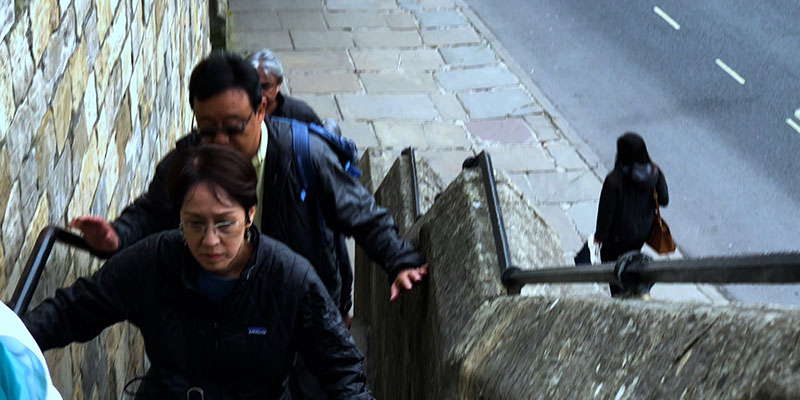
Walk up the short staircase at Bootham Bar, which leads right into the most scenic section, a 1/2 mile route that provides lovely views in both directions, into the town center and beyond to the more modern neighborhoods.
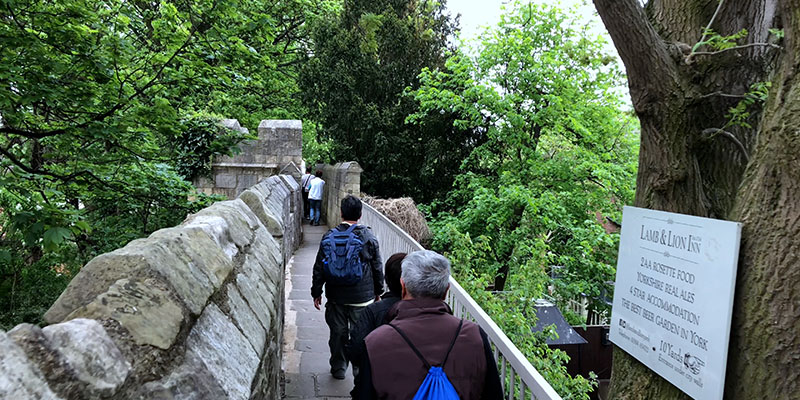
We start from Bootham Bar, walk along the wall, turn the corner to another nice stretch, and then exit at Monkbar, the next gate in the wall. A stroll along the entire 3 miles of the walls would take two hours, or 1900 years, depending on how you see it, for the walk brings you past many of the sites that played a role in the long history of York. The complete walk would provide lovely views in both directions, into the town center, and beyond to the more modern neighborhoods. If you are pressed for time, the best section to cover is the half-mile that wraps around the Minster, from Bootham Bar to Monk Bar, which takes just fifteen minutes. Most people find the short segment is just right.
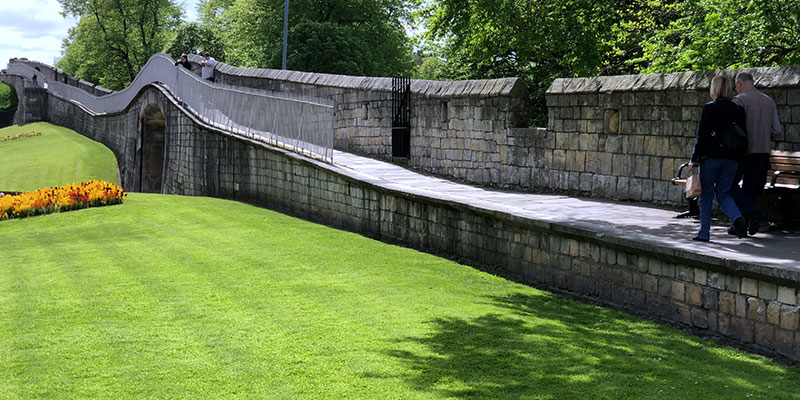
If you were to walk the entire wall, you would pass through the four original gateways that survive today. Monkgate Bar is the tallest gateway, 63 feet high, with four floors containing a museum about Richard III. The main gate was Mickelgate Bar, on the south side where travelers from London would arrive, so this was the showcase where heads of criminals and traitors were displayed on spikes as a warning to all. The heads were boiled and pickled to preserve them, and sometimes stayed on display for many years, despite being pecked by crows and magpies.

Romans were the first to build a wall here, but the massive walls we see today were constructed primarily in the 13th and 14th century. Modifications were made during the Victorian era to make the walls look more attractive, with crenellations added along the top to look like gun slots, and with several large gates cut for roads. Most of the streets just outside the walls have a more recent appearance, such as Gillygate, which was completely destroyed during the Civil War in 1644 and now looks like a typical, attractive shopping street you might find in any country village. You will find a pleasant small-town atmosphere throughout this area outside the walls.
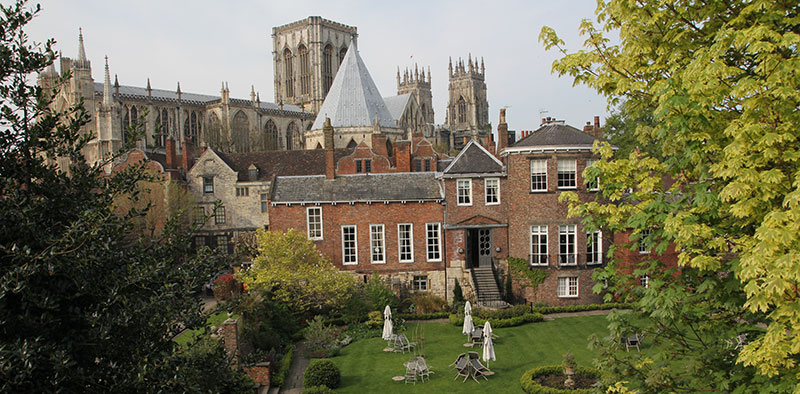
You'll see various angles on the Cathedral, backyard gardens of several mansions, and other fine sights. It was common for Europe's old towns to be surrounded by a protective wall but in nearly all cases the walls are gone and in England only York has such a grand state of preservation, which has really paid off in helping create such a tourist magnet.
In all of Europe there are only a few large, medieval, walled towns standing today, such as Rhodes in Greece, Carcassonne in France, and York. The fortified walls played several very important roles in creating these miracles of preservation: Because the walls were built to protect the town by keeping out the enemy, the space within the walls was extremely valuable and fully developed with a dense concentration of buildings, narrow lanes and no wasted space, creating a fascinating urban pattern that is great fun to explore today.
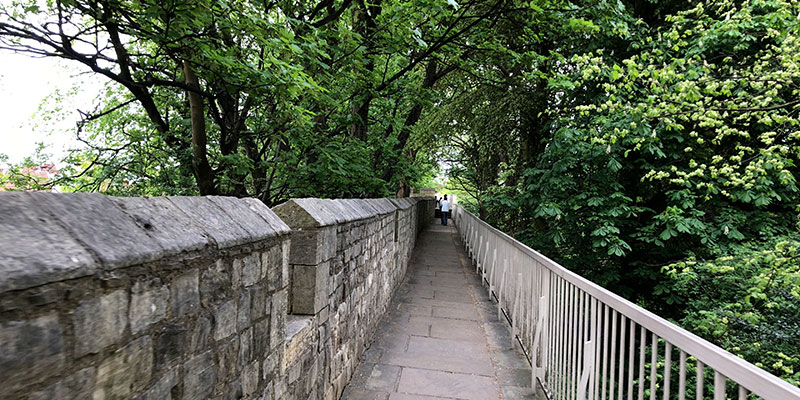
The walls also controlled trade by preventing smuggling, enabling the government to place a tax on goods that came through the gateways and generating revenues for the town to prosper. The same walls have kept modern construction out and made York a time capsule of the Middle Ages.
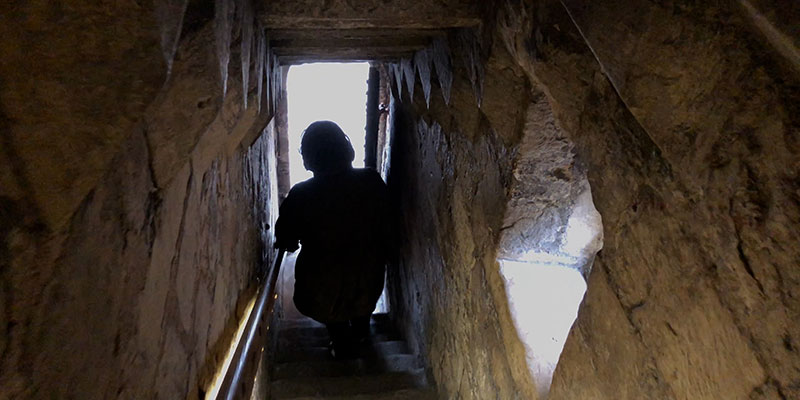
Assuming you took the short route, you come down from the wall at Monkbar put you onto Goodramgate, another one of the many typical pedestrian lanes of town, with many shops that cater to the visitor as well as to the local clientele, and of course you'll find some restaurants along the way.
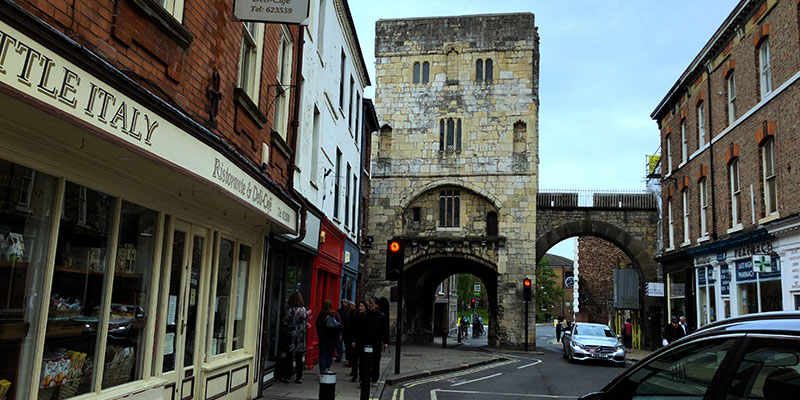
Holy Trinity Church in Goodramgate is set in a leafy courtyard with its original box pews and medieval glass intact. There are box pews, because after the Reformation, when the monasteries were dissolved, the emphasis became on the spoken word and on the family, so these are family pews.
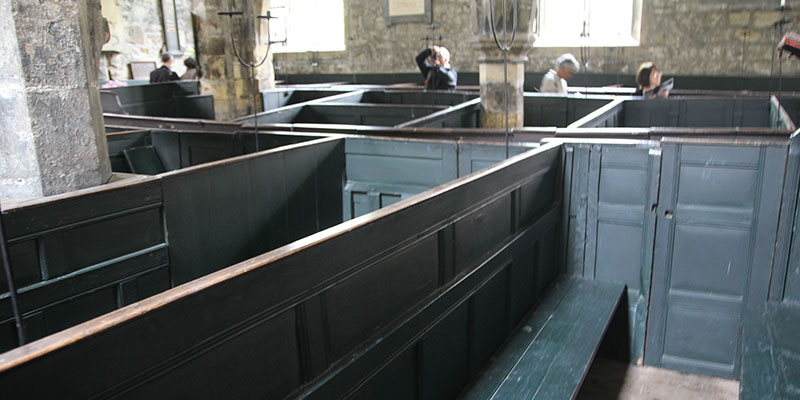
The pews would have been been rented out by the year, which was a brilliant idea because by next year you might have a bigger family or a smaller family. This was quite a small parish, so about 25% of the boxes were free. It was being built at the same time as the Minster. It took a long time to build, about 250 years.
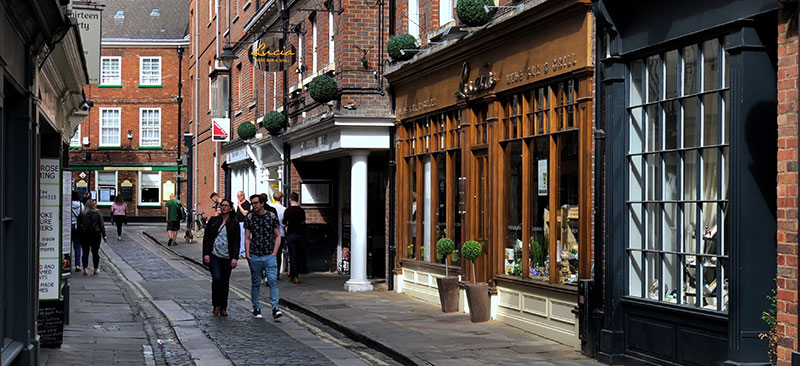
Grape Lane is in the neighborhood with more places to eat, and watch out for those little alleys branching off that sometimes lead to a lovely internal courtyard with more restaurants, offering a peaceful atmosphere, like at Norman Court.
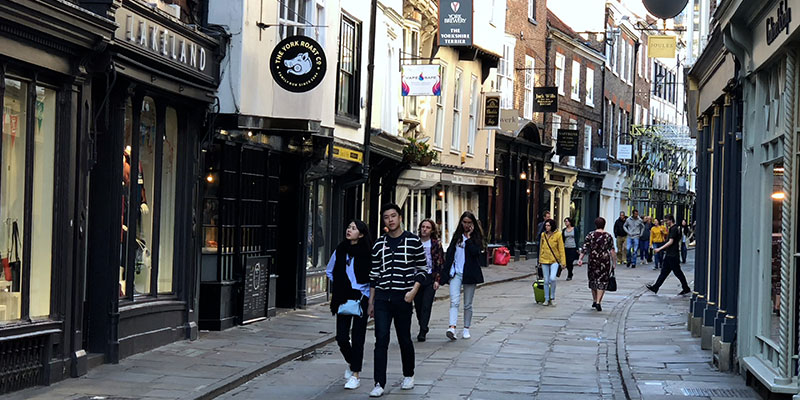
If you'd like to do some stylish shopping in the heart of town, take a stroll along Stonegate, which was one of the original Roman streets, called the Praetorian Road that led to the Roman military headquarters. Now it's a peaceful place to spend some money.
Be sure to look for two famous little statues tucked away in the heart of town just above street level. You'll find the Roman goddess of knowledge, Minerva, at the corner of Petergate and Minstergate looking quite majestic with her white owl and pile of books representing wisdom.
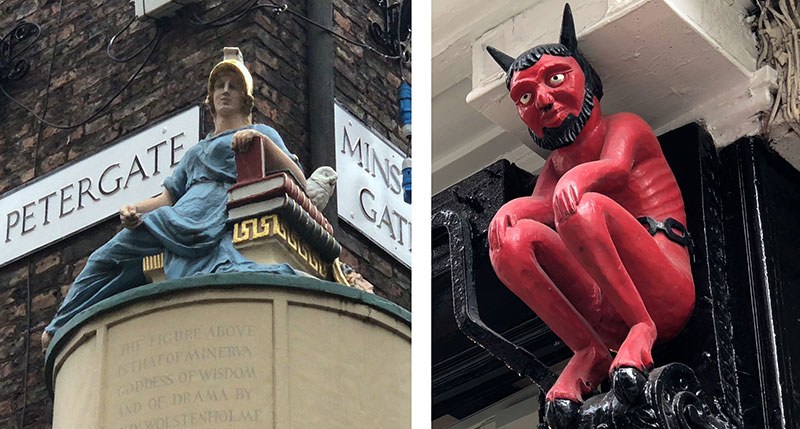
Around the corner on Stonegate, look for the Red Devil, perched just above eye-level on a building adjacent to an alley called Coffee Yard. It is said to represent a "printer's devil," the term for a young apprentice who often caused mischief in a print shop by messing up the order of type in the trays. He has a black chain around his waist to prevent him from stealing bibles, they say, and pulling other pranks on the townsfolk. Up through the 18th century, York had been the center of printing and publishing for northern England.
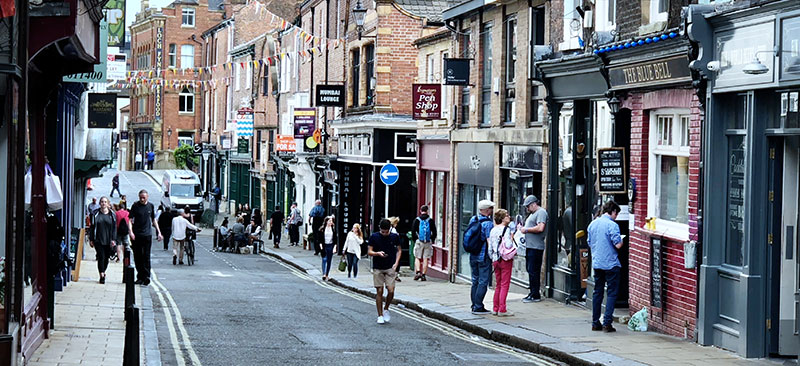
We're now taking a walk along Fossgate, which is a street just south of the pedestrian zone, although it still pedestrian friendly. Only service vehicles and residents can drive here during the day, so it's rather quiet. The city government calls Fossgate "one of York's best-loved streets, with its own special character in the heart of the city. The variety of independent shops, cafés, restaurants, hotels and pubs attracts a diverse range of residents and visitors," slightly off the tourist center so you might get some better prices at the restaurants here. And we are heading this way because it leads to the most spectacular of all the fortified gates in the medieval wall.
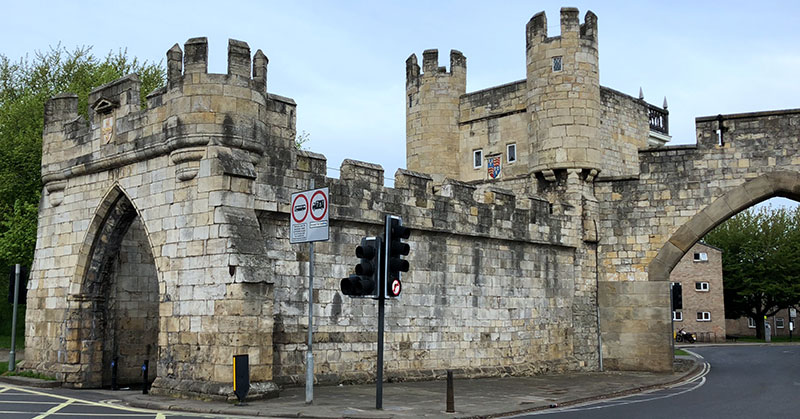
Fossgate changes name to Walmgate as it crosses the River Foss, which continues another 500 meters to Walmgate Bar, one of the major gates in the medieval wall. The arched gates dates back to the 12th-century, and leads into the barbican, which is a fortified extension out from the wall, where invaders would get trapped and be fired upon by the defenders up above. The wall extends out on both sides, and is freely open to the public as part of the wall walk.
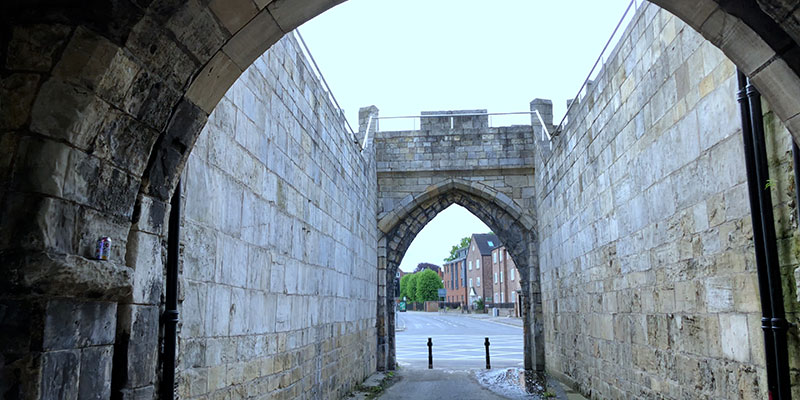
This type of gate extension was typical during the Middle Ages because the gateway was always the weakest point in any defensive wall, so this enabled the defenders to surround anybody who dared attack to keep them out.
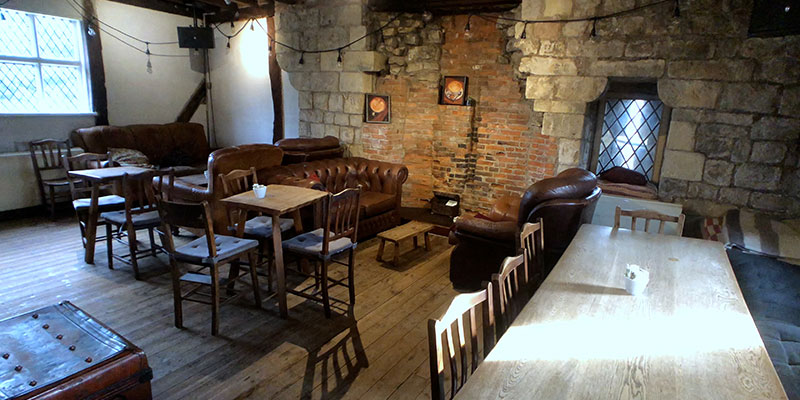
You can go inside the tower and get a close look down at the barbican, and there is a surprise in here. It's a coffee shop, one of the best in town. Convenient shelves for their coffee are part of the portcullis gate that would have been dropped down to seal off the entrance to the city. This interior was a private house for centuries up until 1957. When the gatehouse café is open, you're welcome to walk out onto the barbican.
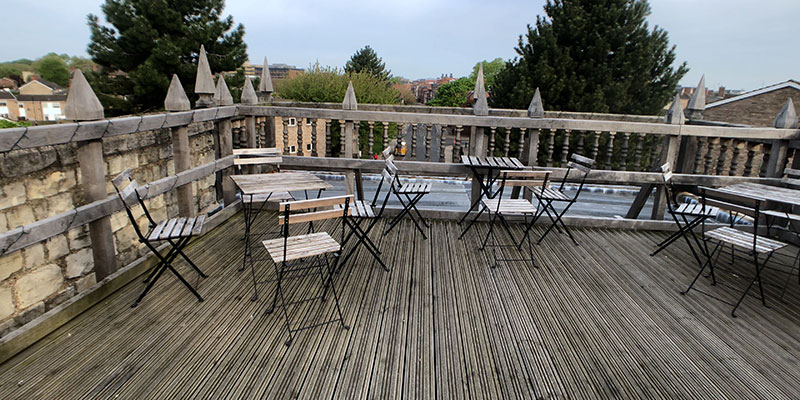
The gate tower has three levels and you're welcome to climb up to the very top, which is an outdoor terrace for the café, with a beautiful view. Other gates in York may have had similar barbicans, but this is the only one to survive and it's the only barbican in the entire country. It was attacked several times, but has been restored to original condition for us to enjoy.
That completes our main walking tour, but keep in mind there are many little side lanes that will tempt you on nearly every block, so hopefully you have the time to deviate from this route any time something catches your eye.
From this south part of town at Walmgate you are in good position to walk for 600 meters along the outside of the wall, passing another major gate, Fishergate Bar, on the way to the York Castle Museum, which is described in our museum page.
While York is compact enough to see on foot easily, you can gain a good overview by taking a tour on the open-top double-decker bus, which runs through much of the town. Sitting on the open upper level of the bus gives you an unobstructed view, and the tour is fully narrated by a local guide who will tell you about the illustrious history and provide some tips about shopping and sightseeing. You could hop off the bus at various sites and then hop back on, but it's better to just stay on board for the circuit and go back to the sites later on foot, since everything is quite close.
If you do get off, it could take fifteen minutes to wait for the next bus. The complete tour is only 45 minutes, so you will quickly be back on your feet and ready to ramble. If it's a rainy day, put the tour off until later, because you really do want to be sitting on top with the open view. Guide Friday bus tours depart every fifteen minutes from Exhibition Square, next to the tourist information office. You can also hop on at any stop and purchase your ticket from the driver.
Today York is a lively place filled with culture, entertainment, shops, characters, legends and fine restaurants. The rich history will come to life in your visit because many of the old forts, palaces, churches and streets are preserved just as they were centuries ago, and several museums help tell the long story. You could easily find 100 things to do in your visit, so it is certainly worth spending three days to see it all.
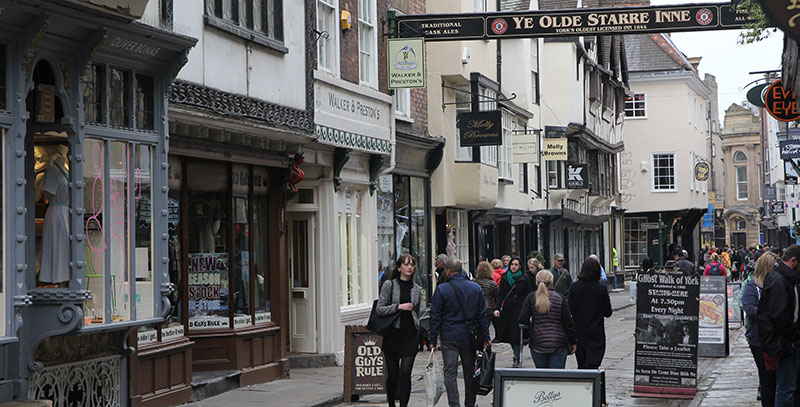
The only problem with York is that it is so popular, which means it can get too crowded. That's how it goes throughout the world with quaint little places that are so spectacular to visit visitors overrun them; but you want to see them too, so don't let this problem stop you. It is such a lovely place that 7 million tourists see it every year, and they could get in your way unless you take some precautions, as we will share here. Hotel occupancy averages 80 percent throughout the year, so it's advisable to reserve rooms well in advance.
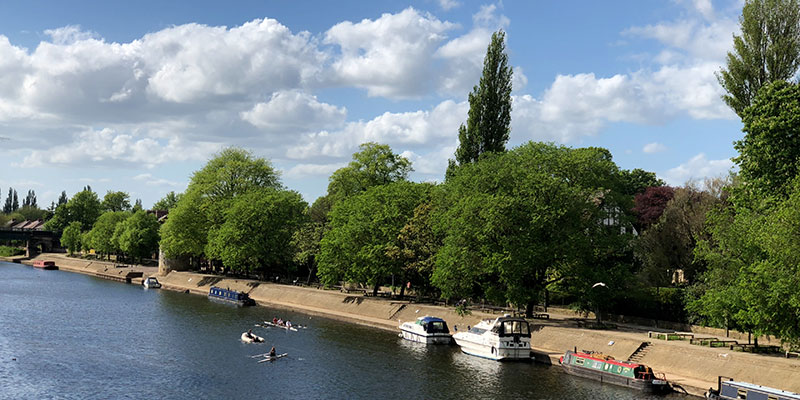
Come in the off-season, if possible, and you'll have no problem with crowds. Great months to be here are April, May, September and October – the weather is good, nice and cool, and there are enough people around to make it interesting but not crowded.
If you do travel in the summer, there are some survival tactics to employ: avoid the main streets and midday, when they are warm and most packed, and perhaps visit museums and other historic sites during the midday. If you do most of your walking tours in morning and late afternoon when the streets are less crowded, you can absorb the historic atmosphere in relative tranquility.
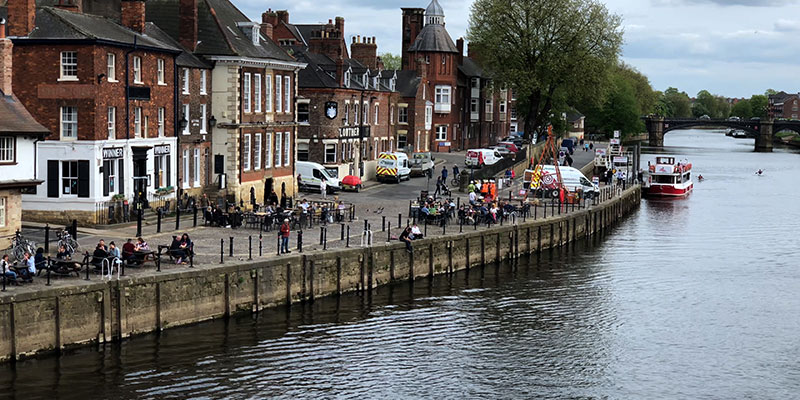
It is possible to visit York as a day trip, perhaps from London, just two hours away by train, so you could spend maybe eight hours walking around in York, and have a nice meal, but that's rushing it. You've seen, there is so much to enjoy in this town. It's worth spending at least one, perhaps two, or three nights. There are many fine hotels in all price ranges to pick from. And then you can explore the Yorkshire Dales and countryside all around it. That's good for another couple of days
It only takes two hours to reach York from London, thanks to the high-speed rail line, and because of this quick access and the size of the town, you might be tempted to do York as a day-trip from London -- but as you learn here, there is so much to see in this medieval gem you really could have fun for several days. However, if one day is all you can spare, come along and squeeze in as much as possible.

Frequent rail service offers 25 trains per day. It should be no surprise that rail service is advanced here because this region has a long history of pioneering train travel. The first station opened in 1839, just ten years after the British invented the steam locomotive. Rapid expansion of train services required a larger station, which opened in 1877 as the largest train station in Europe, and this original steel and glass structure still functions today. If you are arriving without hotel reservations (not recommended), check with the Tourist Information at the station for their list of available space, including many excellent Bed & Breakfasts.
Short Summary
Travel Tips from a hotel manager
Walking tour with local guide
Snickelways of York
Yorkshire Dales